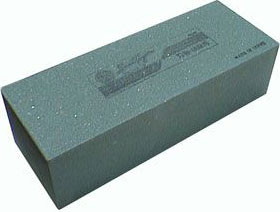Ask the Staff
Question:
I have a set of oil stones that I inherited from my grandfather. They appear to be in fairly good shape, however it takes forever to grind an edge with them. I suspect that they are just very clogged. Can you suggest a way of cleaning the stones? Also, what is a good technique to get them flat and suitable for honing plane blades?
 Answer:
Answer:
Natural oilstones typically fall in the medium to fine category in terms of abrasive grades. If you're going to use them, the first step is to find out what grades of stones you have. Presuming they're Arkansas stones, the grey one will probably be soft (medium grade), the white one will be hard (fine grade) and the black stone will most likely be the finest. One way to be sure is to examine the edge of a tool under a
Pocket Microscope
and notice the surface quality. Now take a dozen or so strokes on one of the stones and notice the difference. Are the scratches left by the stone on the tool finer or deeper than when you started? Try this formula for each of the stones you have and classify them accordingly.
 Next, you need to find a coarse abrasive to initially sharpen your tools. A
200-grit Japanese waterstone
, an
extra-coarse diamond stone
, sandpaper or a slow-speed bench grinder are all reasonable solutions to getting a tool's edge to a place where your soft Arkansas (medium oil stone) can take over. Remember, sharpening is like sanding; start with a coarse abrasive to correct an edge, go to a medium grade to refine it and finish up with a fine stone for honing. Also, whatever you finish the bevel edge with, make sure you do the same for the back of the tool.
Next, you need to find a coarse abrasive to initially sharpen your tools. A
200-grit Japanese waterstone
, an
extra-coarse diamond stone
, sandpaper or a slow-speed bench grinder are all reasonable solutions to getting a tool's edge to a place where your soft Arkansas (medium oil stone) can take over. Remember, sharpening is like sanding; start with a coarse abrasive to correct an edge, go to a medium grade to refine it and finish up with a fine stone for honing. Also, whatever you finish the bevel edge with, make sure you do the same for the back of the tool.
As for cleaning and flattening your stones, I would first clean them with some mineral spirits (paint thinner) to get all the old oil and grit off them. Scrub them down with a toothbrush to remove any stubborn spots. You might have to use a scouring powder as well. After they're clean, check to see if they're reasonably flat. If not, then you can flatten them on a well-broken in diamond stone of any grade. Check frequently, as you go, for high spots with a ruler or straight edge. These procedures should bring your oilstones up to speed. Just remember that oilstones tend to cut slower than some other methods, so make allowances. But I think that's a small price to pay for getting to use your grandfather's stones. Wonderful!
Visit our Sharpening Department
E-mail us
with your woodworking questions. If yours is selected for publication,
we'll send you a free Highland Woodworking hat.
Return to
Wood News
front page

